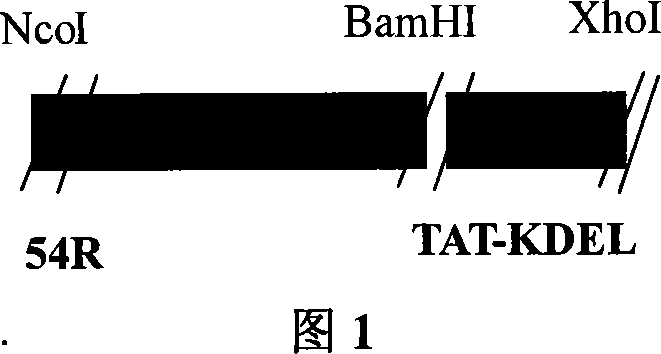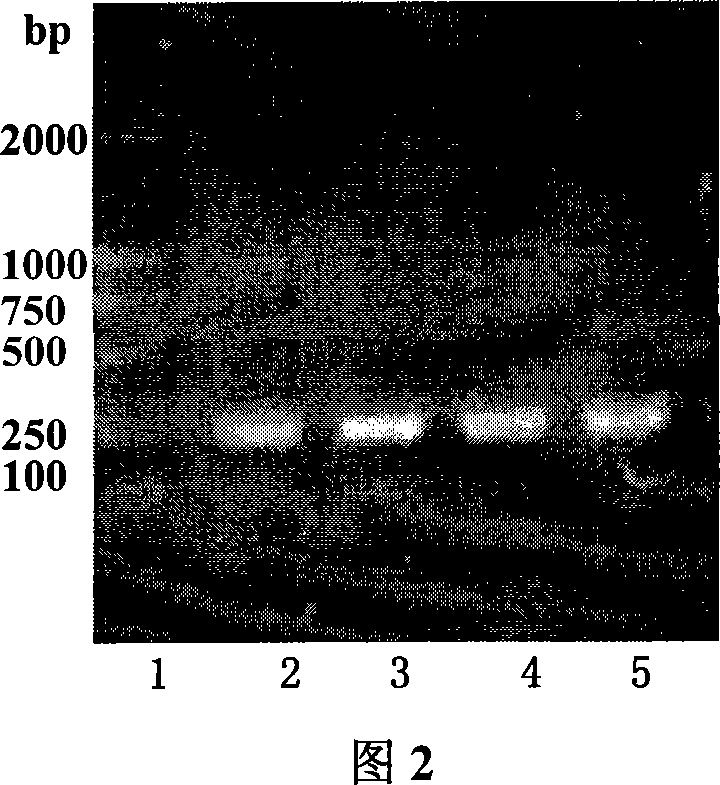Recombined protein having phenotypic knock-out effect on chemotropism factor receptor CXCR4
A technology of chemokine receptors and recombinant proteins, which is applied in the biological field to achieve the effects of high technological content, environmental protection requirements, and large investment returns
- Summary
- Abstract
- Description
- Claims
- Application Information
AI Technical Summary
Problems solved by technology
Method used
Image
Examples
Embodiment 1
[0049] Example 1 Establishment of the prokaryotic expression system of recombinant protein 54R / Tat / KDEL
[0050] 1) Synthesis of Tat (47-57) membrane-penetrating peptide and KDEL fragment: search for the nucleic acid sequence encoding Tat (47-57) and KDEL fragment on the www.pubmed.com website, and connect them sequentially according to BamHI-TAT-KDEL-XhoI Two single-stranded oligonucleotides are artificially synthesized sequentially, and the two strands are reversely complementary. After denaturation at 95°C for 5 minutes, the artificially synthesized single-stranded oligonucleotides are naturally cooled to room temperature, that is, annealed to form double-stranded oligonucleotides acid. The two single-stranded oligonucleotides are as follows:
[0051] A: 5'-GATCCTACGGCCGTAAGAAGCGCCGCCAGCGCCGTCGTAAGGACGAGCTCC-3';
[0052] B: 5'-TCGAGGAGCTCGTCCTTACGACGGCGCTGGCGGCGCTTCTTACGGCCGTAG-3'.
[0053] Among them, the N-terminal of the high-efficiency transmembrane carrier Tat (47-5...
Embodiment 2
[0055] Example 2 Transformation of Escherichia coli BL21 with 54R / Tat / KDEL / pET-28a(+) recombinant plasmid and IPTG induced expression and purification
[0056] Take about 200ng of the correct 54R / Tat / KDEL / pET-28a(+) recombinant plasmid identified by sequencing and add it to 200ul competent BL21(DE3) bacteria (prepared by calcium chloride method), mix gently, and place on ice for 30min. Then heat shock at 42°C for 90 sec, immediately transfer to ice and place for 2min, then add 800ul LB culture solution and shake at 37°C for 45min, take 200ul and spread it on the LB plate containing 50ug / ml kanamycin, 37°C Cultivate overnight (about 12hr), randomly pick 5 positive colonies and inoculate them in 5ml of LB liquid medium (containing 50ug / ml kanamycin) and shake at 37°C for about 12hr, then take 50ul of the above culture solution and transfer them to 50ml of LB liquid medium (containing 50ug / ml kanamycin) was shaken at 37°C for about 3hrs, when OD600=0.5, IPTG with a final concentr...
Embodiment 3
[0068] Example 3 Study on the phenotype knockout activity of CXCR4 in vitro by 54R / Tat / KDEL
[0069] 1) Study on the activity of 54R / Tat / KDEL entering cells
[0070] MOLT-4 cells were treated with 54R / Tat / KDEL for 24 hours, stained with SDF-1-fluorescent antibody, and the efficiency of cell invasion was identified by fluorescence microscope and flow cytometry. 54R / Tat / KDEL increased.
[0071] 2) Subcellular localization research
[0072] MOLT-4 cells were treated with 54R / Tat / KDEL for 24 hours, stained with anti-SDF-1 and CXCR4-fluorescent antibodies, and then labeled with ConA. Confocal microscopy showed that 54R / Tat / KDEL and CXCR4 co-localized in the endoplasm in the net.
[0073] 3) Study on phenotype knockout activity
[0074] After MOLT-4 cells were treated with 54R / Tat / KDEL for 24 hours, they were washed twice with PBS, incubated with anti-CXCR4-PE fluorescent antibody on ice for 30 minutes, and then washed twice with PBS, and the expression of CXCR4 on the cell memb...
PUM
 Login to View More
Login to View More Abstract
Description
Claims
Application Information
 Login to View More
Login to View More - R&D
- Intellectual Property
- Life Sciences
- Materials
- Tech Scout
- Unparalleled Data Quality
- Higher Quality Content
- 60% Fewer Hallucinations
Browse by: Latest US Patents, China's latest patents, Technical Efficacy Thesaurus, Application Domain, Technology Topic, Popular Technical Reports.
© 2025 PatSnap. All rights reserved.Legal|Privacy policy|Modern Slavery Act Transparency Statement|Sitemap|About US| Contact US: help@patsnap.com



